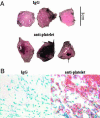Platelets and platelet adhesion support angiogenesis while preventing excessive hemorrhage
- PMID: 16418262
- PMCID: PMC1348013
- DOI: 10.1073/pnas.0510412103
Platelets and platelet adhesion support angiogenesis while preventing excessive hemorrhage
Abstract
Platelets contain both pro- and antiangiogenic factors, but their regulatory role in angiogenesis is poorly understood. Although previous studies showed that platelets stimulate angiogenesis in vitro, the role of platelets in angiogenesis in vivo is largely uncharacterized. To address this topic, we used two in vivo approaches, the cornea micropocket assay and the Matrigel model, in four animal models: thrombocytopenic, Lyst(bg) (platelet storage pool deficiency), glycoprotein (GP) Ibalpha/IL4R transgenic (lacking extracellular GPIbalpha, the receptor for von Willebrand factor as well as other adhesive and procoagulant proteins), and FcgammaR(-/-) (lacking functional GPVI, the collagen receptor) mice. Adult mice were rendered thrombocytopenic by i.p. administration of an antiplatelet antibody. The number of growing vessels in the thrombocytopenic mice was lower in the cornea assay, and they showed significantly increased appearance of hemorrhage compared with mice treated with control IgG. The thrombocytopenic mice also showed more protein leakage and developed hematomas in the Matrigel model. GPIbalpha/IL4R transgenic mice presented increased hemorrhage in both assays, but it was less severe than in the platelet-depleted mice. FcgammaR(-/-) and Lyst(bg) mice showed no defect in experimental angiogenesis. Intravital microscopy revealed a >3-fold increase in platelet adhesion to angiogenic vessels of Matrigel compared with mature quiescent skin vessels. Our results suggest that the presence of platelets not only stimulates angiogenic vessel growth but also plays a critical role in preventing hemorrhage from the angiogenic vessels. The adhesion function of platelets, as mediated by GPIbalpha, significantly contributes to the process.
Figures





References
-
- Wagner, D. D. & Burger, P. C. (2003) Arterioscler. Thromb. Vasc. Biol. 23, 2131–2137. - PubMed
-
- Rendu, F. & Brohard-Bohn, B. (2001) Platelets 12, 261–273. - PubMed
-
- Ruggeri, Z. M. (2002) Nat. Med. 8, 1227–1234. - PubMed
-
- Savage, B., Saldivar, E. & Ruggeri, Z. M. (1996) Cell 84, 289–297. - PubMed
-
- Nieswandt, B. & Watson, S. P. (2003) Blood 102, 449–461. - PubMed
Publication types
MeSH terms
Substances
Grants and funding
- R37 HL042846/HL/NHLBI NIH HHS/United States
- R01 HL041002/HL/NHLBI NIH HHS/United States
- R01 HL042846/HL/NHLBI NIH HHS/United States
- P01 HL031950/HL/NHLBI NIH HHS/United States
- R01 HL050545/HL/NHLBI NIH HHS/United States
- HL56949/HL/NHLBI NIH HHS/United States
- R01 CA064481/CA/NCI NIH HHS/United States
- HL31950/HL/NHLBI NIH HHS/United States
- CA80124/CA/NCI NIH HHS/United States
- R37 HL041002/HL/NHLBI NIH HHS/United States
- P01 CA080124/CA/NCI NIH HHS/United States
- HL41102/HL/NHLBI NIH HHS/United States
- HL50545/HL/NHLBI NIH HHS/United States
- CA064481/CA/NCI NIH HHS/United States
- P01 HL056949/HL/NHLBI NIH HHS/United States
- HL42846/HL/NHLBI NIH HHS/United States
LinkOut - more resources
Full Text Sources
Other Literature Sources
Medical
Molecular Biology Databases

